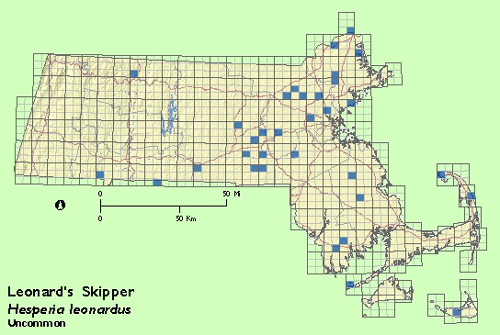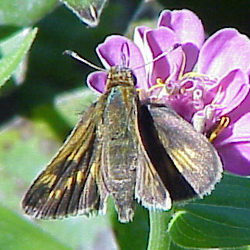Find a Butterfly
Leonard's Skipper
Hesperia leonardus
Named
Harris, 1862

Identification
Wingspan: 7/8 - 1 3/8". A large, richly colored and boldly marked skipper. Both males and females may be distinguished from other species in our region by the bold underwing pattern, which combines a deep reddish background tone with large, sharply defined spots and patches ranging from white to vivid yellow. The thick, prominent stigmal "brand" with a pale center on the forewings of the male is also distinctive.
Distribution
The eastern race leonardus, until recently considered a separate species, ranges from Minnesota and southern Ontario eastward to Nova Scotia and south to Kansas, Louisiana, Alabama and the Carolinas; recent records apparently lacking for Georgia and Florida. Now that the Pawnee Skipper has been "lumped" with Leonard‘s, the range extends westward across the Great Plains to southern Saskatchewan and Colorado.
Occurs throughout New England except northernmost Maine; it apparently drops out in the transition between the northern hardwood and coniferous forest zones.Status in Massachusetts
Occurs throughout the state, but apparently less common to the west; no records from Berkshire or Hampshire counties during the Atlas period. Scudder (1889) says: "...on Cape Cod and along the southern shore it can always be found in considerable, sometimes extreme, abundance (emphasis added), but varies elsewhere according to the year." Today the species appears to be generally uncommon, though its late flight period may be responsible for some collector bias. Maxima: 100+, Wareham (Plymouth Co.), 1989. 15 at Wellfleet (Barnstable Co.), 16 September 1988.

Flight Period in Massachusetts
A late season species that flies between the second week in August and the third week in September. Extreme Dates: 28 February 1990, J. Anderson Nantucket (Nantucket Co.); 2 on 3 October 1994, Wellfleet (Barnstable Co.), J. Sones.
Larval Food Plants
Apparently a wide range of common grasses. Switch Grass, Panicum virgatum; Poverty Grass, Danthonia spicata; and bents, Agrostis, spp. are cited by McGuire (1982) and use of Little Bluestem, Scheuchzeria (Andropogon) scoparia is suspected as a major host at least in southern New England and New York.
Adult Food sources
A wide range of late season composites are used. Opler and Krizek (1984) cite a preference for pink or purple flowers. Nectaring sources observed during the Atlas period include Dogbane, Joe-Pye Weed and Lance-leaved and Slender-leaved Goldenrods.

Habitat
Open areas: grasslands and successional shrublands, pine/oak barrens; may prefer native old fields to pastures as breeding sites; also pitch pine-scrub oak barrens. Recorded from bogs in Virginia (Clark and Clark, 1951) and Glassbereg (1993) notes a close association with Andropogon uplands "(in association) with moist open meadows".
Life Cycle
u>EGG : Large (diam.: 1mm) pale green to white OVIPOSITION: Eggs are laid singly on or near host grasses and hatch in 15-20 days in captivity (Scudder (1889). LARVA: Light brown to pale green covered with short hairs black at the base; head darker brown with cream-colored V-shaped marks on the side. As with most skippers, the leonardus caterpillar builds a tube made of a rolled leaf and lined with silk into which the larva retreat when not feeding and to hibernate. CHRYSALIS: Light brown, spotted darker on the abdomen; an elongate cylinder. OVERWINTERING STAGE: First instar larva.
After emergence in August, males perch in open, conspicuous, sometimes elevated sites, ostensibly on the lookout for mates. They also patrol regular beats amid nectaring plants where females are likely to appear. The spring cycle of larval growth and pupation are imperfectly recorded.
Notes
This is the only single brooded, fall-flying, resident butterfly in New England.
Account Author
Chris Leahy



